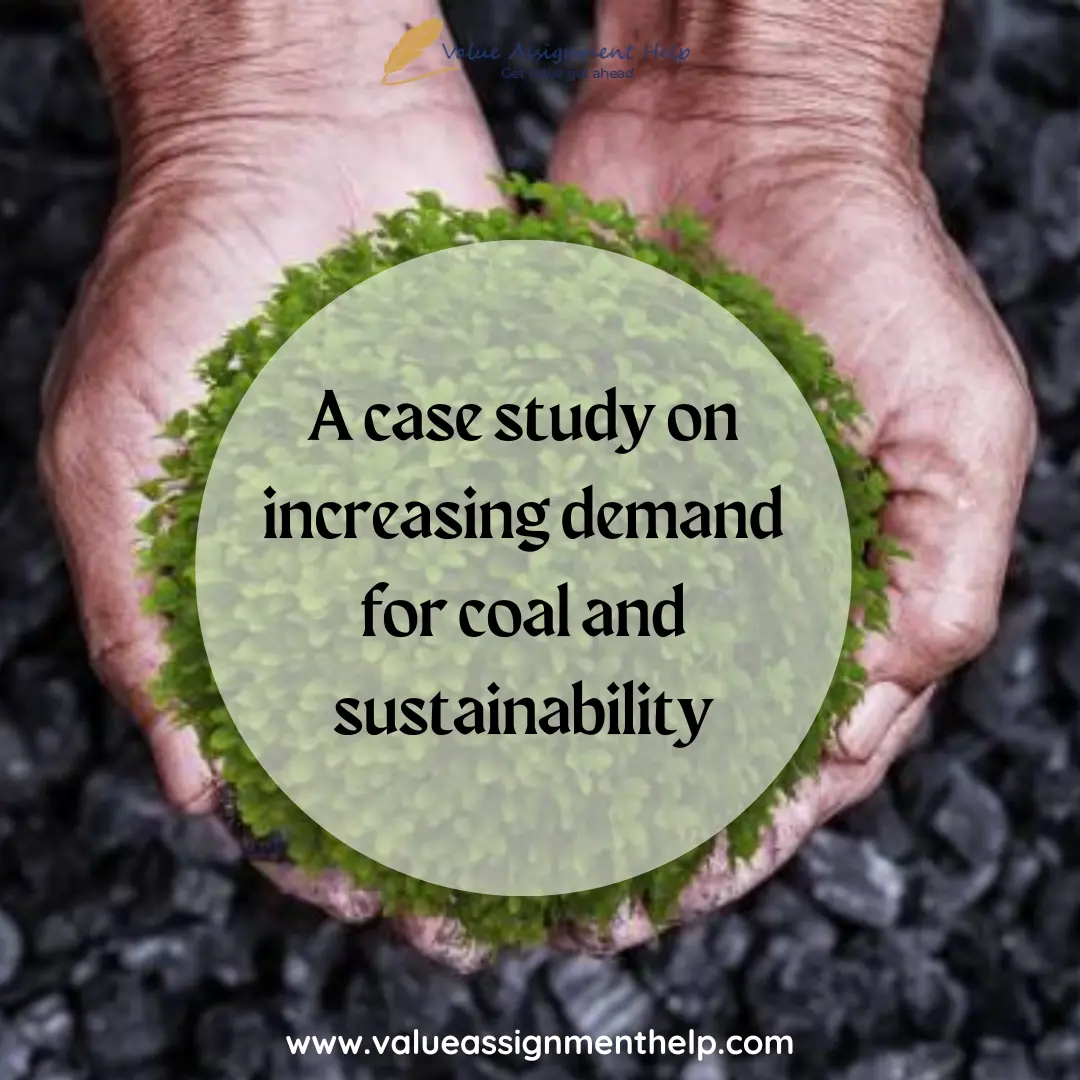
Search Assignments
Table of Contents
Our Experts

Search Assignments

Customers Reviews
While the world clings to coal to meet surging energy demand amid crises, can our sustainability goals still be met?
Coal, the fossil fuel that has powered industry and energy production for centuries, is again in high demand in emerging economies such as India. As economies worldwide continue to recover from the effects of the war in Ukraine and the Pandemic, the need for reliable and affordable energy sources has never been greater. The surged demand for coal is driving up prices and opening up new opportunities for mining companies and communities dependent on the coal industry. But with the growing awareness of the environmental impact of burning coal, this resurgence in demand also raises grave concerns about the futurFutureur planet and our economy. In this case study, we'll explore the reasons for the skyrocketing coal demand, its impact on the global and Indian economy, and the debates surrounding sustaining "green energy".

(value assignment provides the best services worldwide at the most effective prices.)
While it is easy to argue about the sustainability and eliminating coal to the boon green energy sector, it is also vital to understand: What factors contributed to the increase in coal demand?
The Lingering Impact of the Pandemic:
As the world begins to emerge from the shadows of the Covid-19 pandemic, we see a renewed interest in coal as a reliable and affordable energy source. The pandemic has also had a profound impact on gas prices, leading to a subsequent shift to coal, surging demand. The graph shows that after the 2020 pandemic, coal demand rebounded by 5.8% in 2021. (Refer to Graph 1)
War crunched energy demand:
The world is fighting for limited fuel supplies in the "Zero-sum energy game". The escalation of tensions between Russia and Ukraine has profoundly impacted the coal industry, affecting trade, prices, and supply and demand patterns. In addition, the disruption of natural gas supplies to European countries has increased their dependence on coal as an alternative energy source.
Additionally, War in Ukraine led to a sharp escalation in the prices of fossil fuels, particularly natural gas. This further led to a shift in energy consumption, with more and more consumers turning to coal as a more price-competitive option.
Weather Compounded the Issue:
This year, heat waves in China and most of Europe worsened the crises, fueling coal-powered electricity demand to beat the heat. Whereas winter, although comparatively hotter in Europe, the peak demand for coal surged in Asia, especially in India and China.
Coal is the primary fuel for steel and iron production:
Furthermore, as per the "World Coal Association", 71% of global iron and steel production is dependent on coal as primary fuel, and the remaining 29% is produced with electricity as the primary fuel. However, this electricity might or might not be derived from coal. Hence, directly or indirectly, iron and steel production are coal-derived.
The global coal market is experiencing a tumultuous period in 2022 as the traditional trade flows of coal have been disrupted, leading to a surge in prices and an all-time high demand. According to the Coal 2021 market report, demand for coal is projected to grow by 1.2%, surpassing 8 billion tonnes for the first time in history. This trend was predicted in last year's report, which stated that global coal demand might reach a new peak in 2022 or 2023 before levelling off. (refer to Graph 1 and Graph 2)
The trend is mixed when looking at the different sectors of the economy. As per the coal 2022 report, The use of coal in electricity generation is expected to grow by just over 2% this year, but its consumption in the industrial sector is anticipated to decline by over 1%, primarily driven by a fall in iron and steel production caused by the economic crisis. The coal market is going through a complex and ever-changing landscape, making it difficult to predict the future. In addition, the global energy crisis and ongoing geopolitical tensions are impacting it significantly.
Germany is planning to squeeze every bit of coal energy. The nation is struggling to keep up with rising energy demand, from fueling old plants to delaying the commission of existing plants. The scenario is so worse in a few areas, such as Lützerath, villages are being evicted to expand coal mining. In such a scenario, protestors opt to tree houses to protest and protect their villages.
Similar instances have been seen in the United States, where coal power plant retirements are prolonged. As a result, coal production rose by 3.5% in 2022.
Turning to China, Witnessing the surge in demand due to ditching the zero-covid policy in the mainland, China lifts the unofficial ban on coal imports from Australia after two years. The ban was imposed because Australia supported international allegations imposed on China for handling COVID in early 2020.
This surge in demand is particularly evident in India, which planned to sell 20 of its discontinued underground coal mines to private players last year to generate more than 1.2 billion metric tons this financial year.
Additionally, India had set a goal of generating 175 GW of electricity from renewable sources by 2022. However, due to the disruption caused by the pandemic, India has been unable to reach this target and has instead generated only 120 GW. As a result, the country has had to turn to coal to compensate for the shortfall in energy production, which explains the spike in coal energy.
Furthermore, since 2007, coal consumption in India has risen by 6% annually, almost doubling. Compared to 2021, India capped a growth of 14% in coal demand, higher than China (4.6% growth), which is, by the way, the world's largest consumer (54%) of coal.
( Our sample case studies on assignment writing are in the direction of continued help for students to showcase the pointers on how to draft case studies for HD grades)
The surging demand for coal has increased prices and created new opportunities for mining companies. While most of the discontinued underground mines are up and running, the coal industry is booming, but for how long?
The coal demand surge has brought the issue of environmental sustainability back into the spotlight, as burning coal is a significant contributor to climate change. Whether or not to continue to rely on coal for energy production is a complex one that has far-reaching implications for our economy, environment, and future long will coal be in demand:
As per the estimates of the IEA (International Energy Agency), one-third of the global electricity supply, which is presently met by coal, will last for a maximum of 15-20 years, on a stretch, till 2050, not any farther than that. Hence, the famous Paris Agreement to offset global carbon emissions and cap the rise in temperature at 1.5 degrees Celsius is targeted by the end of 2050.
However, the current demand for coal is not estimated to rise any further experts. This is seen as a peak rise due to the waking up of slumbering industries post-pandemic and fuel deficiency due to Russia backing off European supply. But, what is surprising is that demand would hover around the same numbers for years to come. (Graph 2).
Despite the uptick in demand, some factors are slowing the overall growth of the coal market. For example, higher coal prices increased the deployment of renewable energy sources, and a decline in global economic activity contributed to the slowdown.
The increase in demand is not without its challenges, as the use of coal has significant environmental impacts and is a major contributor to climate change. Despite this, the overall outlook for the coal market remains unchanged as various factors continue to offset one another.
However, along with lighting many homes, the coal industry last year accounted for more than 40% of global carbon emissions, which is alarming and disheartening at the same time. On the one hand, coal is the source of electricity; on the other, it is also a ticking bomb for our future. The question that arises at the top is whether we should save the present or secure the future dilemma: Save the present or the FuturFutureesperate times justify unusual economic behaviour to curb power bills", an article published last month in "The Sydney Morning Herald" read, and we could not agree more.
In the UK, people are so desperate to save energy that a third of UK households have reduced cooker and oven use, and almost 50% have turned down the heat in their homes, a study by the Financial Fairness Trust showed. In India, as many as 25 people died in just seven days this month due to dipping mercury thresholds.
We understand sustainability is the way forward. Just as the protesters in Germany claimed (refer to image), switching to green energy is the only "lifeboat" that would keep the human race floating for years. However, amid recent unpredictable crises, the world is faced with tough choices. While most nations are committed to "combating climate crises", as evident in the COP27 meeting of Bali, it is still a long haul. These goals cannot be attained in just a year or two.
We feel just as disheartened as you, but as the world faces global crises, survival is the primary instinct; saving millions from global energy shortage has to be the first preference and climate crises the second. So we understand the dilemma but saving the present to save the futurFutureecessary.
For years to come, Russia will no longer be a "Global powerhouse" due to a dynamic shift in the energy sector. However, for the energy sector to sustain itself, the world does not have enough resources to meet short-term peak demand.
What is more, LNG is seen as the second-best alternative to coal after Renewable energy, but the U.S. is maxed out on its LNG supply. Moreover, Germany's new "sustainable infrastructure" will not be up and running in the coming months. An article in TIME magazine articulated that even a combined supply of LNG from Qatar and the United States will not be able to compensate for the loss of Russian Fuel.
What's worse is that all the renewable sources of energy combined produce only 20% of the total energy produced, which is not insufficient for the current energy needs.
Hence, clinging to coal might be the only way out of these temporary crises.
Switching to green energy is the only way we can survive in there future, seeing that futurFuturevival in the present is imperative. Additionally, the world does not have enough renewable resources to meet rising energy demands. Hence, coal is our last resort.
However, one must contemplate that "Coal is slow poison," which poses no bright future for anyone!
( we are the pioneers in helping millions of students with their college assignments at effective rates )




No Comments